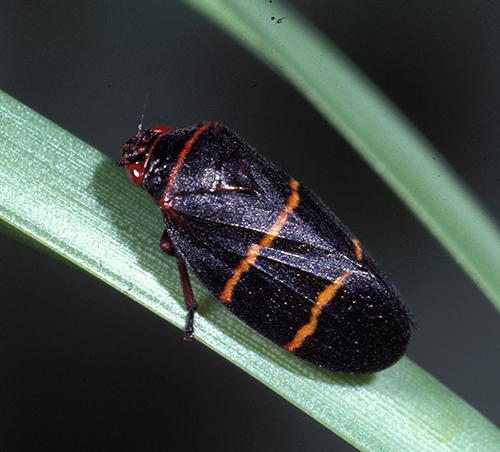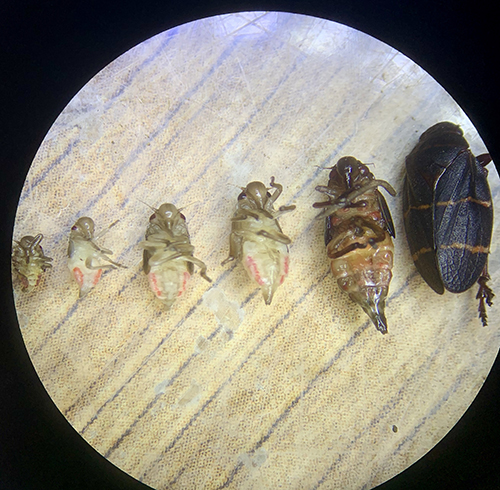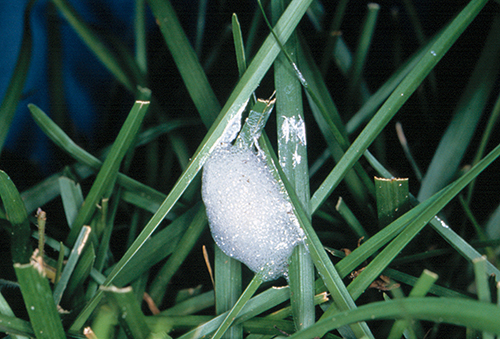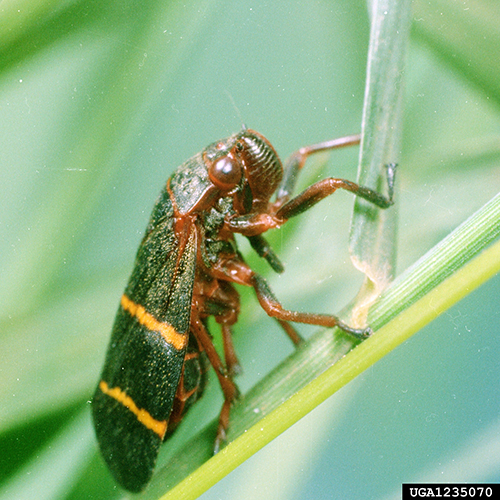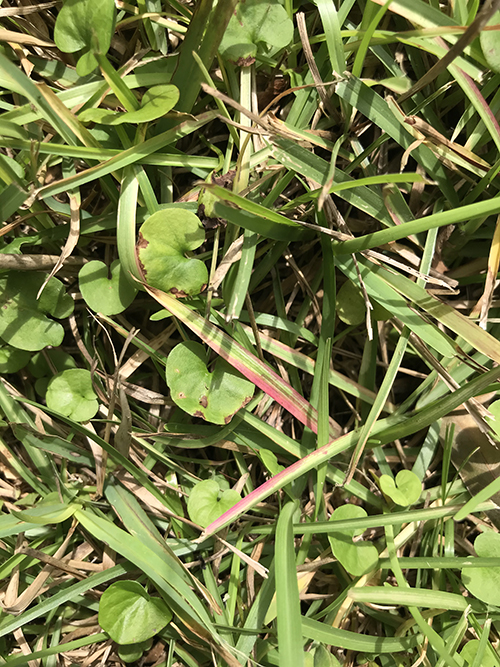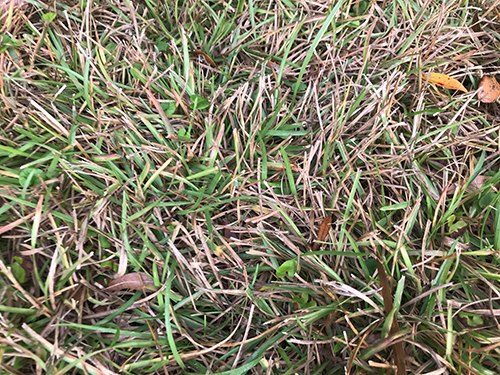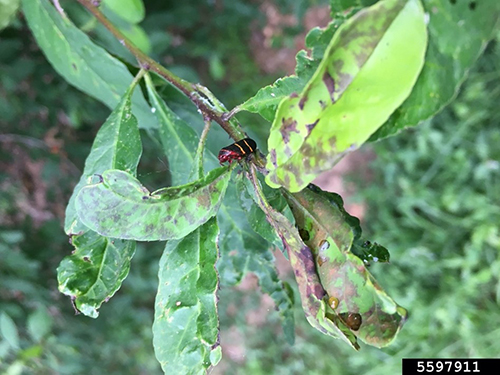common name: two-lined spittlebug
scientific name: Prosapia bicincta, (Say) (Insecta: Hemiptera: Cercopidae)
Introduction - Distribution - Life Cycle and Biology - Hosts - Plant Damage and Economic Importance - Management - Selected References
Introduction (Back to Top)
The two-lined spittlebug, Prosapia bicincta(Say), belongs in the insect order Hemiptera, which includes the hoppers, scales, and aphids. Prosapia bicincta is in the family Cercopidae, the froghoppers and spittlebugs. This name is earned from their impressive leaping ability that allows them a quick exit when threatened or disturbed (Peck, 1998). The common name, two-lined spittlebug, describes the two prominent and parallel lines crossing each wing as well as the protective foamy mass secreted by the immature stages while feeding (Pass and Reed, 1965). This insect is an intermittent pest of warm-season turfgrasses and a few ornamental plant species in urban settings (Potter, 1998). Prosapia bicincta is also an agricultural pest in pasture grasses (Peck, 1998).
Figure 1. Two-lined spittlebug adult, Prosapia bicincta (Say) on turfgrass. Photograph by Lyle J. Buss, University of Florida.
Distribution (Back to Top)
The genus Prosapia is found in Mexico, Central America, South America, and North America (Hamilton, 1977; Randhawa, 2018). Prosapia bicincta has limited distribution west of the Mississippi river including regions in Oklahoma, Kansas, and Iowa, but is widely distributed throughout the eastern United States (Reese, 2007). The two-lined spittlebug can be found as far north as Maine but is most prevalent along the southeastern states bordering the Gulf of Mexico from Texas, east to Florida, and up to North Carolina (Cranshaw and Shetlar, 2017; Potter, 1998). Although Prosapia bicinta can be found throughout Florida, it is most common and pestilent in the northern regions of the state including the panhandle (Buss and Dale, 2017).
Life Cycle and Biology (Back to Top)
The two-lined spittlebug produces two generations per year in the southern U.S. and only one generation per year in the cooler northern states. A third generation in the deep south is possible when environmental conditions are favorable, but it is rare. In the South, first generation nymphs complete development in 34 to 60 days (Pass and Reed, 1965). First instar nymphs emerge from the eggs between March and April and reach maturity by June (Buss and Dale, 2017). Second generation nymphs, which are more destructive due to their size and feeding activity, emerge in late July to early August and reach the adult stage by late August. Adults feed and continue to cause damage to grasses and ornamental plants through the fall and deposit eggs to overwinter (Nachappa, 2004).
Eggs
The eggs of Prosapia bicincta are small, bright orange, and oblong in shape. Eggs average 1.1 mm in length and are typically deposited individually but can also be found in clusters. They are commonly found at the base of grasses near the surface of the soil and occasionally between the leaf sheath and plant stem. Rarely are they deposited directly into the stem (Khan et al., 2019). First generation eggs overwinter and hatch when temperatures increase and turfgrass begins its spring growth from March to April. Second generation eggs are deposited in the latter half of June into early July. The second generation takes approximately two weeks to hatch.
Nymph
Prosapia bicincta undergoes incomplete or simple metamorphosis, hence the nymph is a small wingless version of the adult without the bright coloration. Nymphs and adults feed similarly and in the same area.
Upon egg hatch, the first instar nymph will find a suitable feeding site near the base of a grass blade and produce its signature spittle mass within five minutes of emergence. The spittle mass is a mixture of digested plant sap and air bubbles. The spittle is a result of the large amount of sap ingested by the nymph and the need for excess excretion. The secretions form a bubble mass around the immature insect protecting it from desiccation and helping it avoid predation.
Nymphs progress through five instars with the fifth instar divided into an early instar (5a) and a late instar (5b) (Peck, 1998). An elongated body and wing pads as well as adult coloration distinguish the 5b late instar from the earlier and smaller 5a instar (Peck, 1998). Early instar nymphs lack the signature two lines on their wing pads and it is only the last instar that displays the two crosswise lines on their well-defined wing pads.
All nymph stages are detectable with the naked eye. Nymphs range in size from 1.5 mm in the first instar to 10.5 mm in the fifth instar (Peck, 1998). All early instars are creamy white, yellow, or light orange in color with a brown head, and one orange spot on each side of the abdomen (Buss and Dale, 2017). As the nymph matures it gradually develops the orange aposematic adult coloration on the wing pads and body (Peck, 1998, 1999).
A single spittle mass can contain up to six spittlebug nymphs of varying instars (Fagan and Kuitert, 1969). Nymphs are mobile and will move to an adjacent area in the turf if there is a decline in food quality at the current feeding location. Relocated nymphs will quickly reestablish a spittle mass once they initiate feeding at the new location. Spittle masses are typically found from just below the soil surface to 5 cm up the grass blade. During the heat of the day, the nymphs stay deeper in the thatch layer where humidity is high. They feed higher up the grass blade during the cooler morning and evening periods.
All five nymphal stages feed in a head-down position, which facilitates the thorough coverage and protection of spittle in which the immatures reside (Peck, 1998). The spittle masses can be down in the thatch layer and easily go undetected by the homeowner. Walking across turfgrass with hidden spittle masses gives the feeling of walking across squishy wet carpet and can create a spittle mess on the feet.
Figure 2. Nymphal instars and adult stage of the two-lined spittlebug, Prosapia bicincta (Say). Photograph by Shannon Wilson, University of Hawaii.
Figure 3. Spittle mass created by the two-lined spittlebug nymph, Prosapia bicincta (Say), on turfgrass. Photograph by James Castner, University of Florida.
Figure 4. Newly emerged adult and young nymph of the two-lined spittlebug, Prosapia bicincta (Say), in a spittle mass on turfgrass. Photograph by James Castner, University of Florida.
Adult
Adult Prosapia bicincta measure between 6 mm and 12 mm in length (Buss and Dale, 2017). Like many of the hoppers, wings of the adult two-lined spittlebug are held in a tent-like formation over the back. Adults range in color from a dark brown to coal black with the signature two reddish-orange lines running perpendicular to the body over the wings as well as a thin line of the same color running laterally across the thorax (Potter, 1998). Prosapia bicincta have prominent deep red eyes and possess aposematic coloring on their abdomen and legs with a mix of black and vivid red. These colors are most noticeable when in flight (Potter, 1998). Unlike nymphs, adult Prosapia bicincta do not form spittle masses as they lose the ability to produce spittle after their final molt.
Adult spittlebugs live for up to three weeks and the female can begin laying eggs approximately one week after becoming an adult. The female can produce up to 40 eggs during her short lifetime (Khan et al., 2019). Adult Prosapia bicincta actively feed in the morning and seek refuge from the mid-day heat either down in the thatch layer or within nearby shrubs. Adults are quite active during the evening hours and males are particularly attracted to outdoor lighting. Walking through heavily infested grass in the evening will result in large flights of adults.
Peck (2000) describes reflex bleeding in adult Prosapia bicincta, which is a mechanical and chemical deterrent complete with a defined taste and odor. Reflex bleeding is a defensive response to threats and is the discharge of hemolymph (insect blood) from their pretarsal pads. This defense response creates time for the insect to escape predation. Nymphs do not possess the ability to reflex bleed, but adults are capable of expelling hemolymph within hours of their final molt.
Figure 5. Side view of an adult two-lined spittlebug, Prosapia bicincta (Say) on bermudagrass displaying its red legs. Photographed by Clemson University - USDA Cooperative Extension Slide Series, Bugwood.org
Hosts (Back to Top)
Prosapia bicincta is an occasional economic pest of warm season turfgrasses, favoring bermudagrass (Cynodon dactylon) and centipedegrass (Eremochloa ophiuroides) (Cranshaw and Shetlar, 2017). It will also infest St. Augustinegrass (Stenotaphrum secundatum), bahiagrass (Paspalum notatum), and orchard grasses (Buss and Dale, 2017). Both the adult and nymph stages feed on grasses. This insect can also be an economic pest of pasture grasses, largely bermudagrass.
The adult spittlebug also feeds on woody ornamentals notably ornamental hollies (Ilex cassine, I. cronuta “Burfordii”, or I. opaca), but also redbud and cherry (Cranshaw and Shetlar, 2017). Adult spittlebugs have also been found to feed on asters, morning glory, and other ornamental perennials.
Plant Damage and Economic Importance (Back to Top)
Nymph and adult Prosapia bicincta use their needle-like stylet mouthparts to penetrate the plant tissue and suck out sap. Adult feeding can cause phytotexemia or ‘froghopper burn’ of the plant tissue (Byers and Wells 1966). The component of the saliva that causes the phytotoxemia is unknown, but effects from feeding appear within 24 hours (Nachappa, 2004). In some grasses, specifically centipedegrass, purple, red, and/or white streaking may be observed running the length of the grass blade from insect feeding (Figure 5). Turfgrasses with froghopper burn will gradually wilt, followed by the blade turning brown and dying (Figure 6) (Cranshaw and Shetlar, 2017).
Turfgrass damage caused by adult feeding can be sporadic and patchy due to the mobility of the adults and their ability to also feed on ornamental plants. Turfgrass death is possible in cases of severe infestation, but the result of infestations is more often aesthetic damage. Adult feeding damage in holly can present as wilted, distorted, or general discoloration of young leaves (Figure 7). Older leaves can incur blotchy spots on the underside of the leaf.
In mainland U.S. the presence of spittlebugs in pastureland is sporadic, but there has been concern with two-lined spittlebug infestations in western Hawaii. Large outbreaks have caused extensive die-off of pasture grasses, mainly kikuyu (Pennisetum clandestinum) and pangola (Digitaria eriantha) grasses (Thorne et al., 2018). These forage grasses support close to 70% of the island’s cattle. Invasive weeds quickly establish in the areas void of grass and significantly reduce the amount of land and resources available for cattle grazing. The United States Department of Agriculture (USDA) in conjunction with the University of Hawaii and the Big Island Invasive Species Committee (BIISC) have established research and outreach efforts surrounding the pest (Thorne et al., 2018).
Figure 6. Froghopper burn feeding damage to centipedegrass caused by two-lined spittlebug. Photo Credit: Dr. Adam Dale, University of Florida.
Figure 7. Late-stage damage to centipedegrass caused by feeding of the two-lined spittlebug. Photograph taken by Dr. Adam Dale, University of Florida.
Figure 8. Adult two-lined spittlebug feeding damage to holly (Ilex spp.). Photograph taken by Matthew Borden, University of Florida.
Management (Back to Top)
In areas where Prosapia bicincta are known to be problematic, efforts should be made to monitor the turfgrass after heavy spring and summer rainfall. Monitoring includes searching for spittle masses in the thatch layer. Frothy, sticky spittle residue deposited on shoes can also confirm an infestation when walking across an area suspected of harboring spittlebugs. Adults are easily disturbed and jump or fly as an individual walks through a lawn, so their presence will be evident. Adults are also attracted to lights a night. Therefore, monitoring areas with night lights can help determine if adults are present in the surrounding area.
In southern states, damage from first generation spittlebugs can be evident as early as May. During summer it is second generation nymphs that can cause the most severe damage to turfgrass (Potter, 1998). Establishing and following an integrated pest management (IPM) plan will help to control pest numbers and minimize turfgrass damage.
Mechanical control
A strong blast of water from a garden hose may help dislodge small infestations of two-lined spittlebug nymphs and spittle masses from grass (Reese, 2007). This may need to be repeated and will not provide direct control of the insect, but the continued disturbance can disrupt the feeding of the nymphs and increase the potential of predation by predatory insects through removing the nymph from its protective spittle mass. Nymphs encased within spittle masses can also be handpicked and submerged in a bucket of soapy water to kill the immature spittlebug, although this is labor-intensive.
Biological control
According to Buss and Williams (2005),there have been no confirmed observations ofnatural predators feeding on Prosapia bicincta in the field, but laboratory and greenhouse studies by Nachappa et al. (2006) determined two-lined spittlebug eggs are consumed by most generalist predators that occur in turfgrasses. Eggs were readily consumed by the red imported fire ant (RIFA), Solenopsis invicta (Buren), tiger beetles, Megacephala carolina carolina, andcarabid beetles, Harpalaus pensylvanicus (DeGeer) and Calosoma sayi (Dejean). The study found that nymphs are protected from predation while enclosed in their spittle masses, but subject to predation by RIFA and predatory beetles when spittle is not present. Solenopsis invicta and M. carolina carolina proved to be the most voracious feeders of all three life stages of Prosapia bicincta in controlled settings. According to Potter (1998), the insect-parasitic fungus, Entomopthora grylli, present in late summer, has also been documented attacking adult spittlebugs.
Cultural control
High humidity coupled with steady irrigation and a heavy thatch layer creates an optimal environment that supports spittlebug survival and reproduction, which can result in significant damage to the turfgrass (Potter and Braman, 1991). Following proper cultural maintenance guidelines for turfgrass fertilization, mowing height, and irrigation will result in a well maintained and healthy lawn with reduced susceptibility to spittlebug infestations. If a dense thatch layer exists, it is recommended to dethatch and/or topdress the lawn a with sand or soil mix when appropriate to minimize harborage of the pest (Buss and Dale, 2017). Selecting less susceptible turfgrass species at planting can also help to reduce spittlebug damage in areas known to support pest activity. According to Shortman (2002), zoysiagrass varieties were able to maintain a more normal growth pattern than other turfgrass species evaluated, although they did incur visible injury from spittlebug feeding. Avoid installing centipedegrass where spittlebugs are known to be an issue since this turf species is highly susceptible to spittlebug attack.
Chemical control
Insecticides targeting Prosapia bicincta may be necessary when cultural practices fail to prevent or contain an infestation. Adults are readily controlled with insecticides, but difficult to target due to their mobility. Treatments to both turfgrass and surrounding susceptible ornamentals may be necessary when targeting adults. Due to reduced mobility and smaller body size, nymphs are the preferred target. Targeting the immature stage can be challenging due to their protective spittle mass but following the recommended practices below will help improve efficacy of the chemical application.
- Mow and remove grass clippings immediately prior to insecticide application to enhance insect exposure to insecticide.
- Increase water volume during application to achieve thorough coverage that penetrates the thatch layer.
- Apply insecticide in the late afternoon or early evening when adults and nymphs are most active and feeding higher up in the turfgrass.
- Use insecticides that are more selective for sap-feeding insects and will have reduced impacts to non-target lawn-dwelling arthropods.
Insecticides should be considered only after other management practices have been exhausted. There are a variety of insecticides available to homeowners that are registered for use against spittlebugs in turfgrass. When using pesticides, be sure to read the label to confirm the product is labeled for use against two-lined spittlebug as well as matches the location (e.g. ornamental or turf). When using insecticides, caution needs to be taken to avoid insecticide resistance in the target pest populations through proper rotation of chemical classes while following an integrated pest management program.
Selected References (Back to Top)
- Buss EA and Williams L. 2005. Twolined spittlebugs in turfgrass. EDIS, 2005 (11).
- Buss EA and Dale AG. 2017. Insect pest management on turfgrass. ENY-300. Department of Entomology and Nematology, UF/IFAS Extension.
- Byers RA and Wells HD. 1966. Phytotoxemia of Coastal bermudagrass caused by the twolined spittlebug, Prosapia bicincta (Homoptera: Cercopidae). Annals Entomological Society of America 59: 1067-1071.
- Cranshaw W and Shetlar D. 2017. Garden insects of North America: The ultimate guide to backyard bugs. Princeton University Press.
- Fagan EB and Kuitert LC. 1969. Biology of the two-lined spittlebug, Prosapia bicincta, on Florida pastures (Homoptera: Cercopidae). Florida Entomologist, pp.199-206
- Hamilton KGA. 1977. Rev. of the world species Prosapia Fennah (Rhynchota: Homoptera: Cercopidae). Canadian Entomologist. 109: 621-630.
- Khan FZA, Joseph SV, and Hudson W. 2019. Two-Lined Spittlebug: biology and management in turfgrass. University of Georgia Extension Circular 1157.
- Nachappa P. 2004. Biology and management of twolined spittlebug, Prosapia bicincta (Say) (Hempitera: Cercopidae) in turfgrass (Doctoral dissertation, University of Georgia).
- Nachappa P, Guillebeau LP, Braman SK, and All JN. 2006. Susceptibility of twolined spittlebug (Hemiptera: Cercopidae) life stages to entomophagous arthropods in turfgrass. Journal of Economic Entomology. 99(5): 1711-1716.
- Pass BC and Reed JK. 1965. Biology and control of the spittlebug Prosapia bicincta incoastal Bermuda grass. Journal of Economic Entomology. 58: 275-278.
- Peck DC. 1998. Natural history of the spittlebug Prosapia nr. bicincta (Homoptera: Cercopidae) in association with dairy pastures of Costa Rica. Annals of the Entomological Society of America. 91: 435-444.
- Peck DC. 1999. Seasonal fluctuations and phenology of Prosapia spittlebugs Homoptera: Cercopidae) in upland pastures of Costa Rica. Environmental Entomology. 28(3): 372-386.
- Peck DC. 2000. Reflex bleeding in froghoppers (Homoptera: Cercopidae): Variation in behavior and taxonomic distribution. Annals of the Entomological Society of America. 93: 1186-1194.
- Potter DA. 1998. Destructive turfgrass insects: biology, diagnosis, and control. John Wiley & Sons.
- Potter DA and Braman SK. 1991. Ecology and management of turfgrass insects. Annual Review of Entomology. 36(1): 383-406.
- Randhawa R. 2018. Two-lined spittlebug, Prosapia bicincta (Say). California Department of Food and Agriculture. Pest Rating Profile.
- Reese C. 2007. Two-lined spittlebug (Prosapia bicinta). Horticulture. August/September. 104 (6): 13-13.
- Thorne MS, Fukumoto GK, Wright M, Mack J, Oshiro M, Wilson S, and Oishi D. 2018. Two-lined Spittlebug (Prosapia bicincta (Say)) in Hawaii. University of Hawaii - College of Tropical Agriculture and Human Resources. Factsheet. (11).
